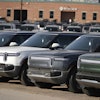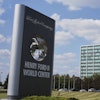Environmental groups are pressing state regulators to reject a petition seeking renewable energy subsidies for trash-burning power plants, saying the incinerators are big polluters that destroy paper, plastic and other materials that should be recycled instead.
The Public Service Commission is expected to rule on Covanta Energy's petition at its meeting Thursday in Albany. Covanta, based in Morristown, N.J., operates 44 energy-from-waste plants in the United States, including seven in New York.
Covanta has asked the PSC to add trash burning to the list of renewable energy technologies eligible for state subsidies. At a news conference Tuesday, the New York Public Interest Research Group and several other environmental organizations said they've asked the commission to reject Covanta's petition, saying incinerators generate air pollution and toxic ash.
Covanta spokesman James Regan disputed the groups' claims, saying the company presented evidence to the PSC that waste-to-energy plants using the latest technology are cleaner than some sources of energy eligible for subsidies. The petition only applies to new plants, not existing ones, he said.
In a report released Tuesday, the Global Alliance for Incinerator Alternatives, a coalition of environmental groups, said the incinerator industry is pursuing a strategy across the nation seeking clean-energy subsidies. The report said most federal energy subsidies that benefit trash incineration are intended to foster the development of renewable energy sources such as wind, solar and small hydroelectric plants.
The report said incineration is the most expensive form of energy production in the United States per unit of electricity produced, citing a U.S. Energy Information Administration finding that the cost of building waste-to-energy plants was 60 percent higher than that of new nuclear plants, and the operating costs are 10 times higher than coal. Harrisburg, Pa., filed for bankruptcy last month because of $300 million in debt tied to a Covanta incinerator there.
In Connecticut, Covanta paid a $400,000 fine in July for releasing unsafe levels of toxic dioxin from its trash-burning plant in Wallingford. In 2009, Covanta paid a $355,000 fine for unsafe dioxin emissions from its Wallingford and Hartford plants.
"Waste-to-energy facilities create more air pollution and climate-altering greenhouse gases than coal plants," said Ross Gould of Environmental Advocates. "Investing in waste-to-energy projects undermines New York's renewable energy goals by diverting money intended for clean energy such as solar and wind."
In documents submitted to the Public Service Commission, Covanta said its waste incinerators in New York routinely operate well below their permit limits for air emissions, with all emissions except nitrogen oxides at least 55 percent below the permitted emission limits and some, including mercury, metals and dioxins, being at least 80 percent below New York's strict emission limits.
Covanta said a new trash-burning plant can generate up to 750 kilowatts of electricity per ton of trash, 14 times more than that produced by landfill gas-to-energy plants, which are eligible in New York for renewable energy subsidies.
According to the Center for Climate and Energy Solutions, 18 states, including Connecticut, New Jersey, Massachusetts and Pennsylvania, recognize municipal waste-to-energy plants as eligible for renewable energy funds.
New York's renewable energy fund, supported by a surcharge on utility bills averaging 25 cents per month, spends about $250 million annually.


















